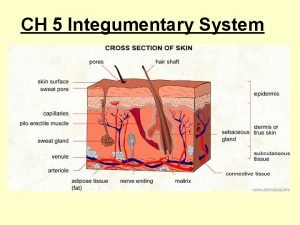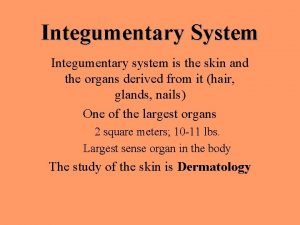Integumentary System Functions Skin color Skin eruptions Functions










- Slides: 10

Integumentary System Functions Skin color Skin eruptions

Functions of the Integumentary System Protection Sensory Perception Regulation of Body Temperature Storage Absorbtion Excretion Protection

Functions of the Integumentary System Protection: n n n Barrier for sun’s ultraviolet rays Protection against invasion of pathogens or germs. Holds moisture in and prevents deeper tissues from drying out. Sensory Perception: n n Nerves are present in skin These nerves respond to pain, pressure, temperature (heat and cold) and touch and send a sensory message to the brain.

Functions of the Integumentary System Regulation of body temperature: n n Blood vessels in skin help body retain or lose heat. Dilate: blood vessels get larger and allow excess heat to escape through the skin. Constrict: blood vessels get smaller and retain heat. Sudoriferous glands also help cool the body through the evaporation of perspiration. Storage n n Skin has tissues for the temporary storage of fat, glucose (sugar), water vitamins, and salts. Stores adipose tissue in the subcutaneous fascia, which is a source of energy for the body.

Functions of the Integumentary System Absorbtion n Certain substances can be absorbed through the skin, such as transdermal medications (nicotine patches, motion sickness patches, certain forms of the flu vaccine) Excretion n Helps the body eliminate salt, a small amount of body waste and excess water. (done through perspiration)

Functions of the Integumentary System Production n n The skin helps in the production of vitamin D It uses ultraviolet rays from the sun to form an initial molecule of vitamin D that is manufactured in the liver.

Skin Color Pigmentation n n Skin color is inherited and determined by pigments in the epidermis. Melanin: 1. Brownish-black pigment 2. Leads to a black, brown, or yellow skin tint depending on racial origin. 3. Absorbs ultraviolet light to tan the skin 4. Small concentrated areas of melanin pigment form freckles. n Carotene: 1. Yellowish-red pigment 2. Also helps determine skin color.

Skin Color Albino n n Absence of color pigments Skin has a pinkish tint Hair is pale yellow or white Eyes are red in color and very sensitive to light.

Skin Color: Abnormal Colors Erythema n Reddish color, caused by burns or a congestion of blood in vessels. Jaundice n n n Yellowish discoloration Can indicate the presence of bile in the blood as a result of liver or gallbladder disease. Also seen in certain diseases that involve the destruction of red blood cells. Cyanosis n n Bluish discoloration, caused by insufficient oxygen. Associated with heart, lung and circulatory diseases. Gray or Brown n Chronic poisonings.

Skin Eruptions Macules – flat spot on skin (freckles) Papules – firm raised areas (pimples, chicken pox, syphilis. ) Vesicles – blisters or sacs full of fluid (some stages of chicken pox) Pustules – Sacs filled with pus (pimples) Crusts – dried pus and blood (scabs) Wheals – itchy elevated areas with an irregular shape (hives and insect bites) Ulcer – deep loss of skin surface that may extend into the dermis. May cause periodic bleeding and formation of scars.



















